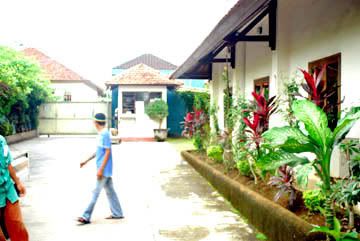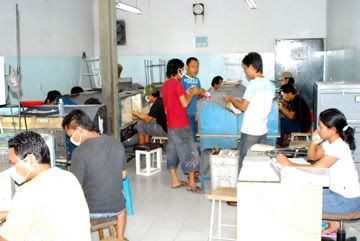Lessons Learned From Two Factory Visits In Bali, Indonesië
Introductie:
In March, I visited factories to better gain and understand areas of issue within international manufacturing along with promoting the need for a cross section of concerned industry insiders to develop specific standards for worker safety.
When we constructed our facility in Santa Fe, we heavily invested in ventilation systems. Over the years, we have also researched solders and fluxes which were as safe as possible. We are constantly looking for ways to improve our work environment.
We brought this practical experience with us when we toured two large jewelry factories in Bali. My company wants to do business only with ethical international partners.
Though I was not acting in any official capacity, I am on the Madison Dialogue steering committee for Manufacturing Standards. In this cross sector initiative, we are in the process of nailing down what exactly constitutes “fair trade” jewelry production.
In Bali:
I started one tour of a factory that employed a few hundred people by meeting with the factory owner.  He showed me an evaluation from an international factory certification agency hired by a large American based customer. They had visited only weeks before and conducted extensive private interviews with employees throughout the plant.
He showed me an evaluation from an international factory certification agency hired by a large American based customer. They had visited only weeks before and conducted extensive private interviews with employees throughout the plant.
I viewed a spreadsheet with their areas of concern and suggestions for improvements which had already been implemented. Red arrows on the floor of work rooms now pointed toward doorways. Exit signs had been added and there were new male and female designations on bathroom doors.
To me, these purported areas of critical risk, which would hold relevance in a large factory elsewhere, were not that meaningful here. Each room where the manufacturing was taking place was less than 600 square feet. No worker was more than twenty-five feet from a direct outside exit. Signs designating gender on bathroom doors, important in some cultures, are routinely ignored in Bali.
Astonishingly, the audit conducted by this international certification agency did not raise the issue of ventilation, which in my mind is a far more serious problem than many of the issues they did raise.
The factory would have gained certification easily were it not for one point: piece worker schedules. Though the wages and over-time conditions for administrative workers were completely in compliance, the bench jewelers who were piece workers worked straight, three weeks on, one week off.
“Why don’t they have time off?” I asked the factory owner.
“They are from Java,” I was told. “Their preference is to work straight for three weeks and then take a week to go home — like people who work on oil rigs or cruise ships. They live here and are offered free housing, lunch and purified water.”
I learned that it takes many of these people twenty-four hours traveling time to reach their families so that taking a full week off allows them quality family time. Many have left their wives and children behind and have come to work voluntarily so far from home, motivated by the opportunity to earn good money.
We brain-stormed about possible solutions. Nog, if the workers were required to take a day off, they would quit. To pay the workers not to work one day a week was not economically viable, either.
This case clearly illustrates the difference between principles and standards.
I would most likely agree with the principles held by the other official organization that came to inspect this factory in Bali. Echter, standards must have some flexibility that takes into account the actual cultural context. More insight in regards to creating a check list of clear standards became evident when I started walking the factory floor.
The workers had been using a borax flux which is relatively safe. Echter, two months before our visit, a local salesman had come by and convinced the production managers to try out a new flux which worked far better. We walked by the desks of the workers, seeing the green fluid in small cans. The new flux contained metals which release toxic fumes when heated with a torch.
Though there was some ventilation, I recommended that the factory switch to a different flux which was not nearly as dangerous. Upon my return to the US, we were able to provide the information on this product, which is not readily available in Bali. There are immediate plans in place to use this safer flux.
Walking further, I found one room using glue compounds which are dangerously toxic. When this was pointed out, immediate plans were made to improve ventilation. This led to a discussion about how toxic the local environment was. Denpasar, where the plant is located, is smoggy from leaded gasoline that many employees breathe every day on their motorbike commutes to and from the factory.
On another day, I visited a different factory manufacturing product for export. The rooms there were air conditioned, but without ventilation. Paste solders were being used, as well as an odorless oxidation agent. These were applied in a closed space without ventilation.
As we asked questions about their fluxes, solder and oxidation agents, the woman giving us the tour kept on asking us, “Is this dangerous for long life health?” Apparently, no one had ever raised the issues we pointed out. After the tour, I was able to meet with the upper level management of the plant. I was encouraged. On the drawing board were plans for an entirely new ventilation system to be installed later this year.
These kinds of oversights occur because people in management positions are often business oriented and not experts in jewelry production. Production managers who work on the floor are often local hires and used to working with compounds that may well be dangerous. Often, they consider it part of the accepted way of doing things because that has been their own experience. Their main concern is whether the product makes the job easier. This is one reason why continuing to educate them is so very important.
It is not unusual for people in developing countries to be ignorant of the dangers in the chemical compounds they use. In the Indonesian language, there is only one word for acid. No distinction is made for hydrochloric acid, sulfuric acid, of citric acid. What works best for production and what is cheapest to use, trumps all.
The issue of safety for bench jewelers is difficult in any plant. Many bench jewelers have set ups in the US without any ventilation at all, even though they know better. Their excuse is, “I don’t do much soldering. I mostly work in wax.” In my company, we invested heavily in safety. But over the years we still have to come down hard on our employees to make sure that they are wearing masks and eye protection.
Larger factories exporting heavily to western customers are often able to deal with these issues far better than smaller, home grown industries that might qualify as “fair trade” producers.
Worker safety for those cottage industries producing “fair trade jewelry” certainly is important. At the very least, it would be helpful if workers in the smaller plants using dangerous materials could be supported with information that could improve their chance of “long life health.” Even a small change, like moving from a room with four walls to a space that has more cross ventilation, can make a huge difference.


